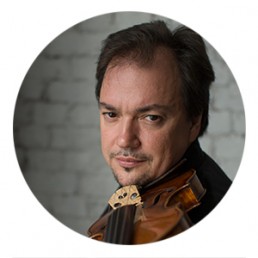STRAUSS | PROKOF'EV | Bartók
Henrik Nánási / Sergej Aleksandrovič Krylov, violino
Filarmonica of the Teatro Comunale di Bologna

Maestro Nánási was born in Pécs, Hungary. After studying piano and composition at the Béla Bartók Conservatory in Budapest, he enrolled in the University of Music and Performing Art. After his first engagements in Klagenfurt and Habsburg, he became Principal Conductor and Deputy Chief Conductor at the Staatstheater am Gaertnerplatz in Munich. General Music Director of the Komische Oper in Berlin from 2012 to 2017.
Effervescent musicality, stunning virtuosity like a refined instrument always at the service of expressiveness, intense lyricism are just some of the qualities that have made Sergej Krylov one of the most renowned performers on the international scene. He is currently the Musical Director of the Lithuanian Chamber Orchestra with which he loves to explore in the dual role of conductor and soloist a very large repertoire ranging from Baroque to contemporary music.
Program
RICHARD STRAUSS
Don Juan op. 20
SERGEJ PROKOF’EV
Violin Concerto n. 2 in G minor op. 63
BÈLA BARTÓK
Concert for Orchestra
ComposERS
Don Juan op. 20
Composition: 1888
First performance: Weimar, Hoftheater, November 11, 1889
Movements:
- Allegro molto con brio
- Molto vivace
Written by Strauss at the age of 24, Don Juan is one of the first symphonic pieces by the German composer. The structure of the symphony follows the dramatic evolution of the events of Nikolaus Lenau’s poem Don Juans Ende, on which Strauss’s composition is based. The image of the protagonist is perfectly transferred to music: a seductive hero is presented to the public, whose parable is destined to fade away in the silence of death and disillusionment.
Violin Concerto n. 2 in G minor op. 63
Composition: 1935
First performance : Madrid, December 1, 1935
Movements:
- Allegro moderato
2. Andante assai
3. Allegro, ben marcato
More conventional than Prokof’ev’s first audacious compositions, the concerto opens with a violin melody that refers to traditional Russian folk music. A melody that runs throughout the second movement and ends by taking up the opening theme of the violin. The third movement is a rondo that has a taste of Spain, with the beat of castanets that underlines from time to time the return of the theme.
Concert for Orchestra
Year of composition: 1942-1943
First performance: Boston Symphony Hall, Boston, December 1, 1944
Movements:
- Introduction: Andante non troppo; Allegro vivace
- Couples game: Allegretto scherzando
- Elegia: Andante non troppo
- Intermission interrupted: Allegretto
- Final: Pesante, presto
During the American years, even if physically undermined and concerned about his financial situation, Béla Bartók manages to complete the orchestral concerto commissioned by Kussevitskij. Written within the tonal system, it uses a great variety of linguistic-musical means: it passes from the influences of Serbo-Croatian music of the II tempo, to the episodes of counterpoint elaboration in the III, up to the “mixed” Hungarian song of the IV tempo, with elements drawn from black folklore, parodied in the Finale.




